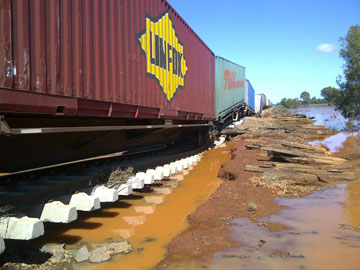
The ATSB has warned rail transport operators of the importance of having robust systems to monitor and mitigate the risks to infrastructure from significant weather events. This warning comes after an accident near Roto in New South Wales which left a locomotive derailed and several of its trailing wagons damaged.
The accident occurred on 4 March 2012 when the train, consisting of two locomotives and 45 freight wagons, was travelling from Sydney to Perth. There had been a significant amount of rain in the region of Roto that morning—more than a 50-year rainfall intensity event. The Bureau of Meteorology had issued a severe weather warning for flash flooding for the district. As the train approached Roto, light rain was still falling.
A mentor driver was supervising the trainee driver who had control of the train when he observed ‘white water’ flowing over the track ahead. Under the mentor’s instructions, the trainee applied the train brake. Then the mentor driver intervened directly: he moved over to the controls and applied full dynamic braking, and then the full independent and service brake as well. He then resumed his seat and instructed the trainee driver to brace, should the train not stop before entering the water. It didn’t.
The flooding had caused scouring of the track formation, compromising its capacity to support the train.
As the train entered the water, the crew felt significant impacts with the locomotive hitting two distinct dips in the track. The second dip sent water up to cover the locomotive windscreen. The lead locomotive remained on track, but the trailing locomotive uncoupled and collided with the rear of the lead locomotive. No one was injured, although the locomotives, trailing wagons and the track were damaged.
The ATSB determined that runoff from the heavy rain had caused a flash flood event. The floodwater exceeded the capacity of a drainage culvert, which resulted in water overtopping the track formation with ballast and sub-grade scouring on either side of the culvert. The magnitude of that scouring meant that the track could not support the weight of train 7SP3 as it passed over the affected areas. The resulting deformation in the alignment of the track initiated the derailment.
The ATSB also identified a safety issue with the track manager’s systems and operational procedures. They provided only limited information and guidance to network control staff in identifying and assessing the potential threat from the weather.
The track manager is now trialling the use of flood sensors at high-risk locations and has engaged the services of a third party to provide early warning information on potential high-risk weather events.
Read the final report: Derailment of freight train 7SP3, near Roto, New South Wales, on 4 March 2012


